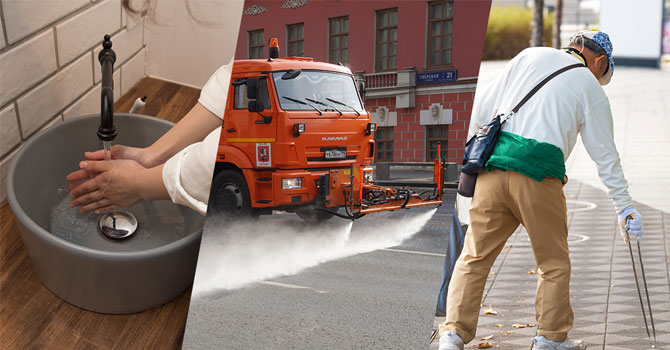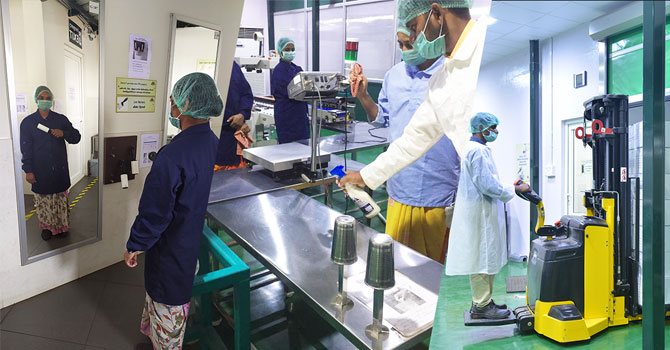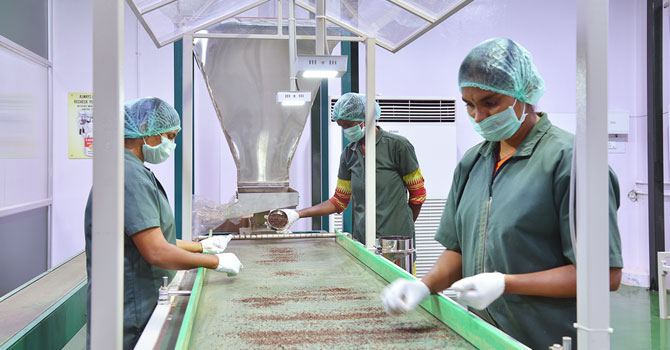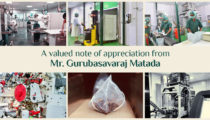Raising the levels of hygiene standards: Taking a leaf out of Japan’s culture

The distinction of being the only tea organisation in India to collaborate with Japanese partners speaks volumes of the mutual commitment to maintaining excellent standards of hygiene and cleanliness. The joint venture, A. Tosh Ishimitsu, became a reality as both companies share, uphold, and holistically promote the culture of hygiene. As a tea supplier to Japan, where hygiene holds great importance, there are further opportunities to learn and benefit from the globally acclaimed Japanese hygiene practices to improve the existing standards at the A. Tosh Facility.
Japanese people follow strict personal hygiene and cleanliness habits. Being recognised as one of the cleanest countries in the world, people have high awareness about hygiene matters and practice good habits such as washing hands regularly. They prefer using anti-bacterial or bacteria-removal products for sanitization purposes.

We encourage the staff at A. Tosh facility to inculcate hygiene and cleanliness practices to ensure our products meet the highest of hygiene standards and to prevent the spread of diseases and/or infections. Aside from having a proper infrastructure that is geared towards maintaining hygiene, we also have put procedures and training programs in place to ensure good hygiene is maintained continuously. Every entrance to the facility has an attached hygiene station. The entrance to the Tea Bag Plant has been thoughtfully designed, aligned to the most stringent Japanese standards.

The practice of Uchimizu refers to the sprinkling of water in the streets and gardens. While it does not directly contribute to public health, it keeps dust settled and the sprinkled area stays cool. People in Japan are encouraged to perform Uchimizu with recycled water to raise awareness about the environment and sustainability. Remote villages and small towns in India also need to adopt similar hygiene practices. We, at A. Tosh and Sons, are inspired by our Japanese counterparts to maintain cleanliness not only inside the facility, but also in the surrounding areas leading to the campus.
Much before the current global pandemic broke out, Japan had adopted the culture of wearing masks. This habit ensures good health by preventing the spread of germs and sickness in public places where people can come in close contact with each other and may be at risk. Different ways of wearing a mask in Japan indicate sickness or prevention. When they wear the mask, the line showing outside means the person is sick. If wearing the other way, it means the person is not sick but is wearing it as a precautionary step. Face masks, available in a variety of colours, sizes, and designs, are a good defence against dust and pollen particles that lead to asthma attacks in the spring season.

Similar personal protective equipment (PPE) such as hair cap, face mask, and gloves as well as workwear is available at the A. Tosh facility. Each worker uses a ‘lint roller’ to remove any loose hair, threads, dust, lint, etc., that may be present on the workwear, before proceeding to the handwash station. Before proceeding to the handwash station, the workers change into work footwear. Mirrors are installed for self-checks, to ensure proper cleaning as well as the use of proper workwear.

One of the messages that ties into Japanese daily practices of cleaning and living is to commit oneself to tidying up. Many people in Japan live in households with limited space. As a result, staying organized and tidy becomes essential. One successive benefit of an organized environment is that it is naturally easier to clean and maintain. The Konmari Method, as described in Marie Kondo’s 2014 bestseller, teaches ways to reduce clutter. To cite an instance, with her distinct way of folding clothes, she takes care of how clothes are folded. This kind of search for detail and commitment reveals the overall mindset of neatness that Japanese people have. At the A. Tosh Facility, our employees maintain clutter-free surroundings. Items lying scattered due to lack of storage space reflect poorly on organizing skills. Keeping things well-arranged and in proper order helps save time in accessing the needful items quickly. We follow a quick disposal policy where the excess or non-essential items are removed from the facility at regular intervals to avoid accumulation and overloading problems that slow down efficient work processes and routine operations.

Japanese people make a clear distinction between ‘the indoor’ and ‘the outdoor’. Anything brought in from the outside is considered ‘unclean’. This is not only applicable to private homes but also pertains to public spaces. There is an entrance area where one takes off their shoes and changes into indoor slippers. The same practice is encouraged when entering bathrooms – a separate pair dedicated to bathroom use. Something similar is followed at the A. Tosh facility where separate footwear for the restroom facilities is available. The Semi-Hygiene Area includes separate change rooms and personal locker areas for men and women. The workers change from their footwear into semi-hygiene area footwear immediately upon passing through the entrance.
Most public schools in Japan do not employ a janitor. Students are taught to clean from a young age – to instill the importance of maintaining and caring for one’s space. An orderly garbage disposal ensures there is no litter around, no piled-up garbage vats rotting for days. Being accountable for one’s mess and self-service cleanups are given importance in the society. The public transport system is kept squeaky clean as people think of it as their own property and being a representation of their country – hence, a matter of pride.

In public places, people do not talk out aloud as it can be a disturbance for others. At Japanese railway stations, staff members have assigned times to clean the inside of the trains when they are stopped. Whenever there is any repair work on the road in progress, it is done systematically, without causing any disruption to the people, and completed without any breaks, delays, or extensions.

At the workplace, there is a standard of cleanliness and organization based on 5S: Seiri (sorting), Seiton (organizing), Seiso (cleaning), Seiketsu (sanitizing), Shitsuke (sustaining). A. Tosh and Sons follows these steps in the workplace as it helps not only with waste reduction, but also leads to a tidy workspace that is beneficial to increasing focus and productivity. Japanese people regard cleanliness as a reflection of oneself. This approach was highlighted by global news outlets when Japanese fans and spectators at a FIFA World Cup event took the initiative to clean up the stadium at the end of a game.
Ensuring cleanliness and hygiene inside our facility is one of the core concerns as the safety of consumable products matters for our reputation. While the techniques and methods can be different from one country to another, the vision to have a clean and hygienic environment remains the same. A. Tosh and Sons puts in every possible effort to ensure that the world inside the facility resembles what prevails across Japan where reevaluation of healthy practices is the current norm after the Covid-19 outbreak. It is a leaf we take out of the Japanese book of cleanliness and hygiene, to incorporate newer measures at par, and dynamically implement them to upgrade our existing parameters of hygiene and safety.



